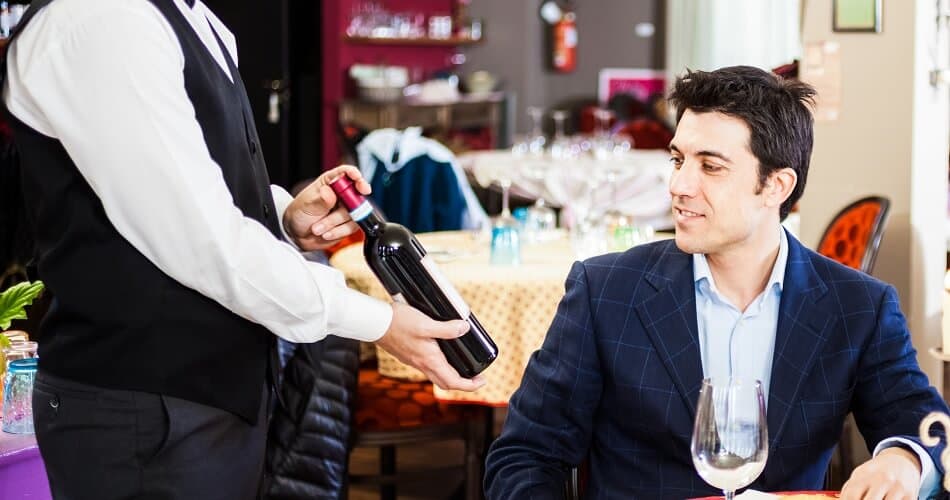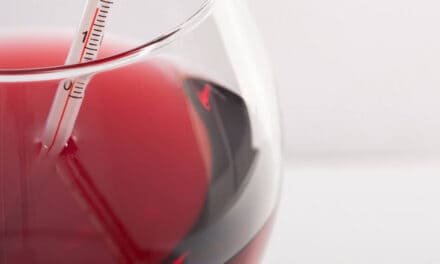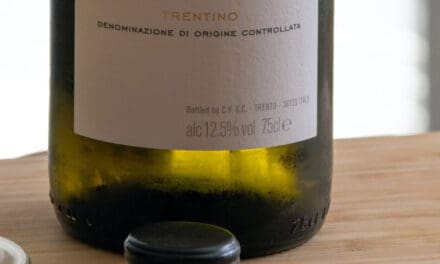When you order wine at a restaurant, follow these guidelines:
- Choose your wine based on your meal and the restaurant style.
- Set your price limit and stick to it.
- Be courteous and specific with your sommelier, whether you order wine for the first or the 101st time.
- Before approving wine, carefully smell and taste a sample.
- Always ask for your sommelier’s opinion before declaring a wine fault.
Following these basic steps will make your wine order much more pleasant for everyone involved. Nevertheless, there’s more information about these steps that will make for an even more enjoyable experience. If you internalize the following tips, you can order wine like a pro.
HOW TO CHOOSE WINE
Even if you do not know which dish you want to order and which wine might match it, you can do a few things ahead of time to make your choice at the restaurant easier. Here they are:
Look at the Wine List Ahead of Time
Many restaurants post their wine lists online. Take a few moments before you go to the restaurant to check its website and study its wine list. You might recognize one you like, and mentioning it to your sommelier will make the process much easier. But even if you cannot recall any wine, the list can help. Research the wines on it, and you might come up with new insights that help you order wine at the restaurant.
Check for a “Sommelier’s List”
Some restaurants with large wine lists feature a shorter “Sommelier’s List”. Much like a “Specials List” on a dinner menu, this collection contains interesting wines and the sommelier’s favorites. It is basically the concentrated wine knowledge of a well-trained professional. If you have no idea, simply order wine from this shortlist.
Order Regional Wines
The best combinations of food and wine typically come from the same region. For instance, if you are at an Italian restaurant, you should go for all-Italian food and wine pairings.
In many cases, you can narrow down your picks: Pay attention to the food menu and what region it best represents. For example, if the menu is more Mediterranean-themed, choose a wine from a Southern Italian region.
When in doubt, let the sommelier (or the waiter) recommend a food and wine pairing to you. They simply know the outstanding dishes and bottles best.
Know Your Price Range
When you order wine without having in-depth knowledge about prices, you might fall for one of the marketing tricks that some restaurants use. To make sure you get the best deal for your money, here are a few tips:
- Do your research. As a general rule of thumb, restaurants add 200% to 300% to the retail price for bottled wines. If you are concerned about cost, check the wine list and the retail prices of your top choices beforehand.
- Watch for markup. While it may be tempting to snatch up the best deals on the menu, the least expensive wines typically are grossly marked up. So even if you order wine that is rather cheap, you might pay too much money. Again, make sure you’re not getting duped before buying.
- Do not fall for the “second cheapest” trick. With the cheapest bottle out of the picture, the second cheapest seems to be the best option. But in most cases, they are not. Restaurants know all too well that diners who do not want to break the bank will gravitate toward this option. Thus, markups can be excessive here too.
- When in doubt, order wine from the middle. If the price dilemma is too overwhelming, just order wine from the middle of the price range. These mid-range wines generally offer the best price-quality ratio.
Step Outside of Your Comfort Zone
Finally, do not be afraid to order wines from lesser-known regions or with unfamiliar grape varieties. Many diners stick to their favorite wines from the most prestigious regions. But they often overlook hidden gems that are both delicious and fairly priced.
HOW TO ORDER WINE
The next challenge is to give your wine order to the sommelier. Pronouncing the names of Italian or French correctly might be an intimidating task. Nevertheless, do not be afraid to look (or sound) like a fool. Even many wine professionals pronounce wine or varietal names in a way that would make the local vintner’s ear bleed.
Remember these simple steps, and you can order wine without breaking a sweat.
Know Your Preferences
Make sure to give your sommelier at least some hints about your wine preferences. Even if you cannot name a specific wine or a varietal, tell him or her if you prefer reds or whites. If you cannot decide, use your meal as your guide, as certain foods pair better with reds or whites.
Besides the color, you might have likes and dislikes regarding other characteristics. If you can name these preferences, you will help the sommelier make a much better wine recommendation. These are the wine characteristics you should know:
- Varietal: The varietal is the name of the grapes that a wine is made from. Popular varietals are, for instance, Cabernet Sauvignon, Chardonnay, or Pinot Noir. If you like a certain varietal, communicate this to your sommelier.
- Body: Also known as mouthfeel, wine body refers to the texture of the wine inside the mouth. Light-bodied wines have a thin, watery texture, while full-bodied wines are rather creamy. Wine body can also be a good indicator of alcohol content: Wines with a high alcohol content typically have a full body.
- Tannins: Tannins are the compounds in grapes that give you a mouth-drying sensation when drinking. They also contribute bitter notes. The level of tannins in wine massively impacts the drinking experience. So letting your sommelier know whether you prefer a high-tannin wine or a low-tannin wine will lead to a much better wine recommendation.
- Bouquet: The bouquet is the combination of aromas a wine develops during fermentation and aging. Typically, a rough description of your preferences, such as “fruity” or “earthy”, enables the sommelier to help you order wine that you actually like.
Set Your Price
Be very direct with your sommelier about your price range. If you are uncomfortable stating it out loud, point to a bottle on the list that’s within your range, and tell your sommelier you’d prefer something like it.
Glass or Bottle
You should know whether you want a glass or a bottle when you order wine. There are approximately five glasses in a bottle. If you are with a large group of people who have different wine preferences, it is more affordable to order by the glass. However, it is generally cheaper to order by the bottle if your peers have a similar taste.
Be Kind to Your Sommelier
This rule should go without saying – just be nice! Your sommelier’s job is to help you. If you’re kind, personable, and ask relevant questions, your sommelier will be much more inclined to help you find the perfect wine for your meal.
HOW TO APPROVE YOUR WINE
After taking your wine order, the sommelier will get a bottle from the wine cellar and present it to you to approve the wine. Be aware that a good sommelier always lets the person who made the order approve the bottle. In case, you are not this person, do not ask to check it. But if you are, there are a few key processes that will help you ensure that what you get matches your wine order.
Check the Bottle Label
First, the sommelier presents the bottle to you. Take a moment to check the wine’s name, the varietal, and the vintage year to ensure they’re correct. If the sommelier makes the label visible and, after opening the bottle, it turns out to be the wrong wine, the blame is on you.

Patron Checking a Wine Bottle’s Label
Check the Wine’s Temperature
Touch the bottle with the palm of your hand to check its temperature. If it’s too warm, it should be chilled down. And if it is too cold, you should wait a couple of minutes before drinking.
Inspect the Cork
After letting you approve the wine bottle, the sommelier pulls the cork out and places it on the table. You have the chance to inspect it, now. The cork should be damp on one side, indicating that it was stored properly. If it looks dry or crumbly, the wine might have suffered from oxidation.
You should not sniff the cork, though. The sommelier or other patrons might consider that pretentious. And the cork’s smell won’t give you much information anyway.
Taste the Wine
Next, the sommelier pours a small sip of wine into your glass. To approve it, you should follow these steps:
- Swirl the Glass: Give your glass a few swirls to aerate your wine and help it release its aromas. Have an eye on the wine to make sure there aren’t any cork pieces in it.
- Take a Sniff: After swirling it, bring the glass directly to your nose and take a long, deep sniff. Feel free to do this a few times to capture all the different smells in the bouquet. If the wine smells moldy, musty, or burnt, like wet cardboard or vinegar, that’s a clear sign that it went off and is not drinkable anymore.
- Sample the Wine: Take a small sip of wine and let it sit in your mouth for a few moments before you swallow. If the wine tastes as it should and you can’t detect any off-flavors, give your sommelier a sign of approval.
- If you choose the wine, keep it. Take this as a general rule of thumb: You selected it, so the blame is on you. Keep the bottle and pay for it. In case you try to send it back anyway, expect some resistance from the sommelier or the restaurant owner.
- If your sommelier chose the wine, send it back. If you put your choice in the hands of the sommelier, they will likely be more inclined to take the bottle back and help you choose a new one.
- In any case, do not be aggressive or condescending. Instead, be courteous and kind to your staff. You may find they are willing to take back a perfectly good bottle of wine regardless of the situation.
WHEN AND HOW TO SEND WINE BACK
Sending a bottle of wine back is an uncomfortable scenario that diners and sommeliers want to avoid at all costs. Nevertheless, it does happen. Here are a few different reasons to send your wine back and how to handle each situation appropriately.
The Wine is Faulty
In case, your wine tastes or smells like it is faulty, that’s a valid reason to send it back. Politely mention to your sommelier that it does not taste right. No matter how obvious the fault is, always ask for the professional’s opinion, instead of declaring your conviction immediately. If the sommelier confirms the fault, the restaurant should replace the bottle without questions.
The Wine Tastes Funny
You may encounter a scenario where something in the wine tastes strange, but you cannot point out the problem exactly. In this situation, politely describe the flavor you are experiencing. The sommelier may be able to explain the unique flavor – or confirm the bottle actually is faulty.
You Just Don’t Like the Wine
Finally, there might be nothing wrong with the wine, but you just do not like it. That is surely the most unpleasant situation, and every wine lover and restaurant owner will have a slightly different stance on this matter. If you order wine and return it although it is good, that is a financial loss for the restaurant. So be aware of that before you start a dispute.
Here there are a few generally-accepted guidelines for this scenario:
FINAL WORDS
It can be intimidating to order wine and approve it, especially in restaurants with extensive wine lists. But with the rules in this guide, you are well prepared to master these situations. Always remember: At the end of the day, most sommeliers and restaurant owners put customers first as long as they are polite and kind. So do not hesitate to ask for help and wine recommendations.






